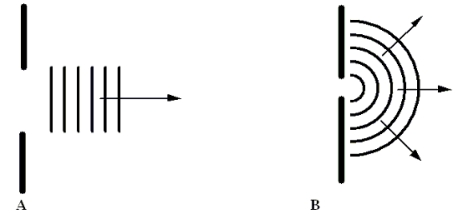Water waves approach an aperture. The resulting patterns are shown for two different cases, A and B, in which the wavelength and aperture size are varied.  Which one of the following statements concerning these cases is true?
Which one of the following statements concerning these cases is true?
A) Neither figure shows diffraction. In both cases, the wavelength is much smaller than the aperture.
B) Diffraction occurs in A, but not in B because the wavelength in A is much smaller than the aperture.
C) Diffraction occurs in B, but not in A because the wavelength in B is much smaller than the aperture.
D) Both figures show diffraction. In both cases, the wavelengths are approximately the same size as the aperture.
E) Diffraction occurs in B, but not in A because the wavelength in B is approximately the same size as the aperture.
Correct Answer:
Verified
Q1: For a diffraction horn loudspeaker,sound emerges through
Q2: Two pulses of identical shape travel toward
Q3: Two identical tuning forks vibrate at 587
Q3: Consider the figures depicting rectangular pulses on
Q6: Two timpani (tunable drums)are played at the
Q7: Two loudspeakers, A and B, are separated
Q9: For a diffraction horn loudspeaker, the
Q10: Two loudspeakers are located 3.0 m apart
Q18: A pebble is dropped in a lake;and
Q19: Sound waves are emitted from two speakers.Which
Unlock this Answer For Free Now!
View this answer and more for free by performing one of the following actions

Scan the QR code to install the App and get 2 free unlocks

Unlock quizzes for free by uploading documents